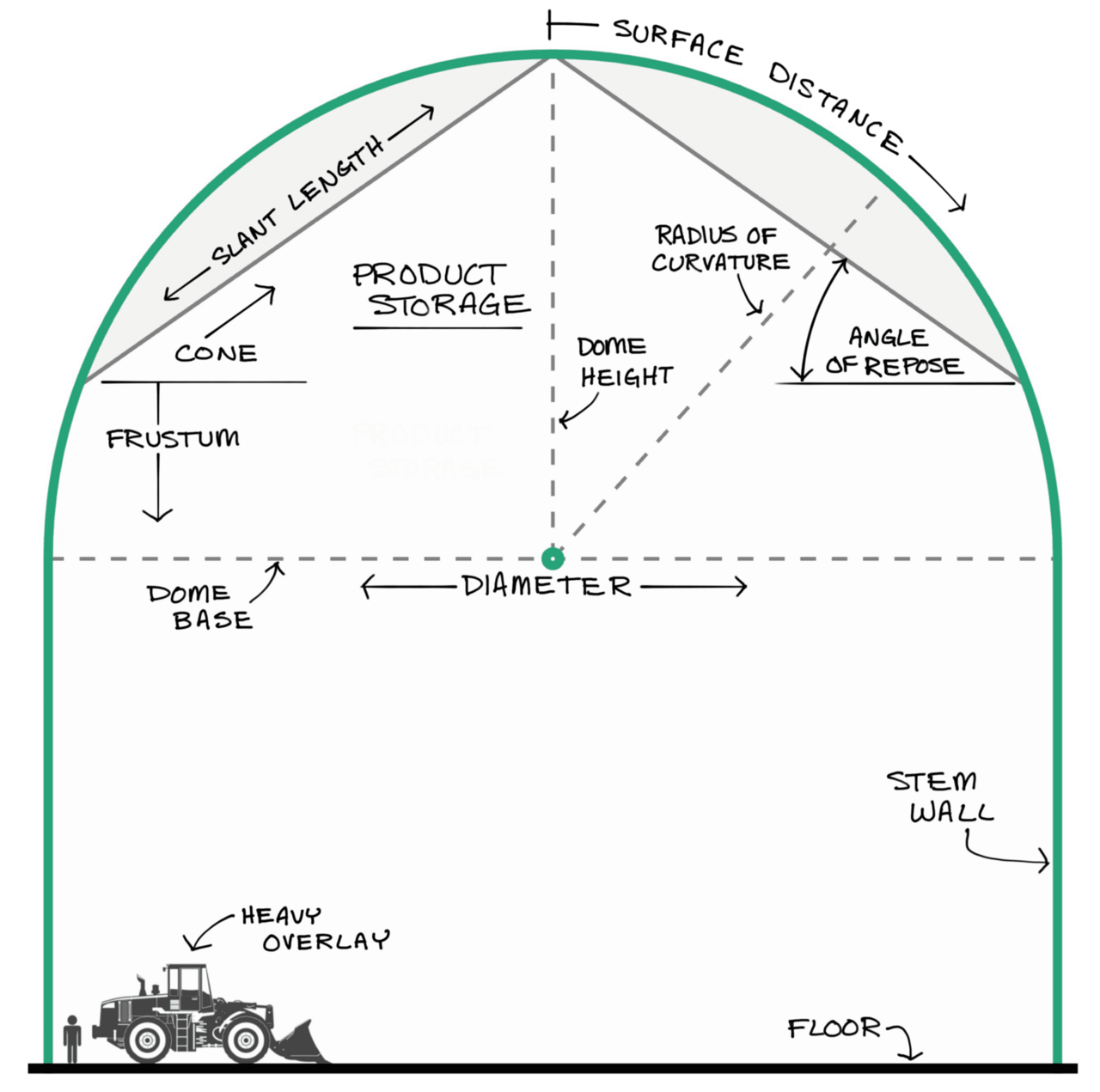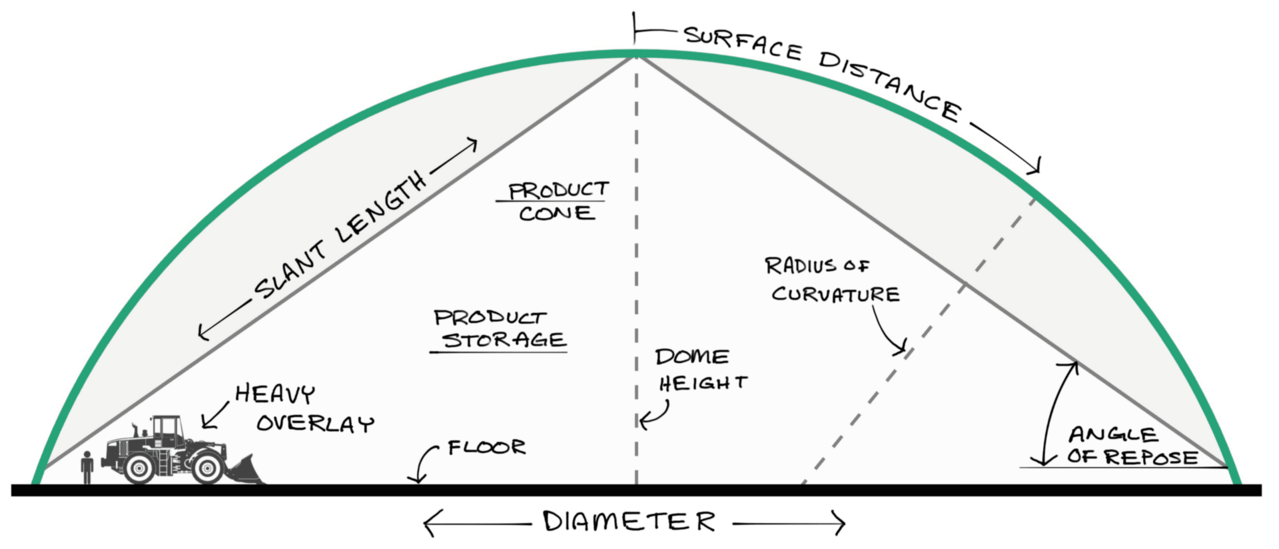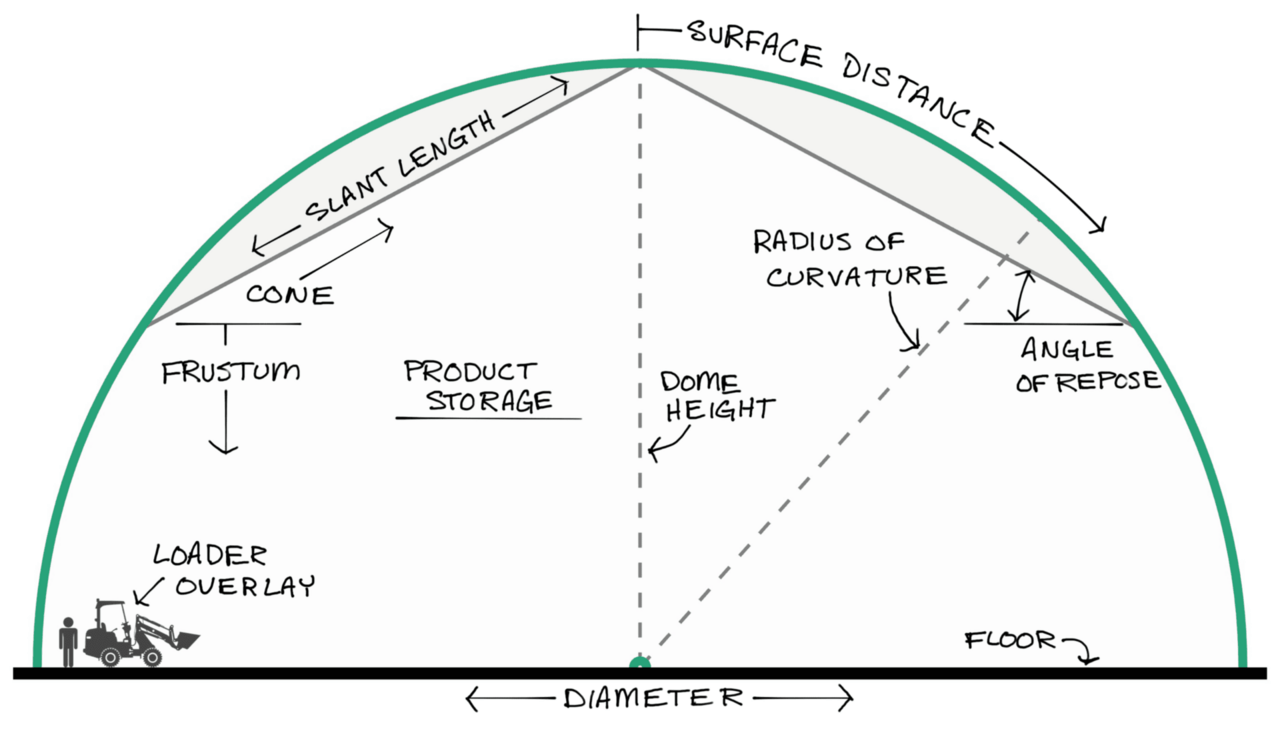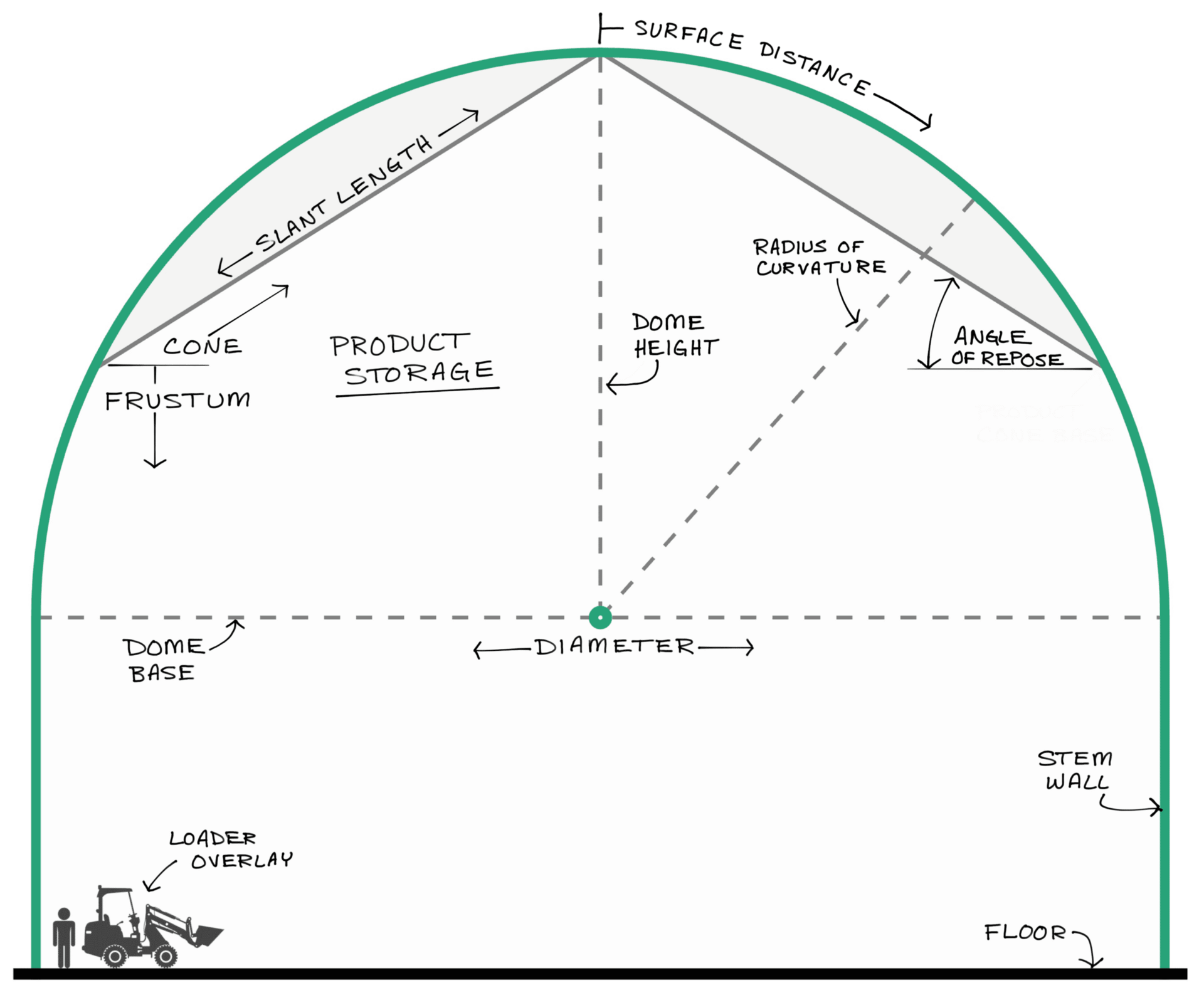Dry Bulk Storage Dome Calculator
Product Reference
Click product density to auto-populate the storage calculator.
| Product | angle | lbs/ft³ | kg/m³ |
|---|---|---|---|
| Ammonium Nitrate | 32° | 50 | 800 |
| Ammonium Sulfate | 38° | 65 | 1040 |
| Cement, Clinker | 35° | 85 | 1360 |
| Cement, Portland | 12° | 90 | 1440 |
| Coal, Bituminous | 35° | 50 | 800 |
| Coal, Lignite | 38° | 40 | 640 |
| Corn | 21° | 45 | 720 |
| Distillers Grain | 32° | 30 | 480 |
| Fly Ash | 20° | 60 | 960 |
| Gypsum | 35° | 75 | 1200 |
| Iron Ore | 30° | 120 | 1920 |
| Limestone | 38° | 90 | 1442 |
| Peanuts | 35° | 20 | 320 |
| Phosphate | 30° | 60 | 960 |
| Potash | 25° | 70 | 1120 |
| Salt | 25° | 75 | 1200 |
| Sand | 25° | 100 | 1600 |
| Soda Ash | 32° | 60 | 960 |
| Soybeans | 24° | 50 | 800 |
| Sugar | 35° | 55 | 880 |
| Sulfur | 30° | 55 | 880 |
| Urea | 32° | 48 | 770 |
| Wheat | 28° | 48 | 770 |
Using the Dry Bulk Storage Dome Calculator
The MDI Dry Bulk Storage Dome Calculator is designed to calculate storage capacities of various materials and products poured into the top of the dome, filling the structure, and forming a pile with a cone shape at the top. It can calculate a wide range of storage buildings from low-profile pile-cover designs to tall silo-like dome structures.
It is a general-purpose calculator where all product details and dome measurements are determined by the user. The Product Reference table contains a list of commonly stored products with a recommended angle of repose and density values—imperial or metric. These are linked to calculator templates to help start the design process.
Click “Switch to Sizer” to copy product details and calculated capacity to the Dry Bulk Storage Dome Sizer. Note that dome size may change as the sizer recalculates dimensions based on the transferred product capacity.
Calculator parameters are stored in the page URL and can be bookmarked, saved, or shared. Use “Copy Link” to share the URL or click “Copy Results” for an email-friendly copy of all results. Print or save the page as a PDF for a professional copy of the drawing and results.
Be aware that just because the calculator can draw a structure, it does NOT mean the structure can be built. This calculator is just a tool. Always consult with qualified professionals before proceeding with a project.
This calculator is subject to our Terms of Service.

Complete dry bulk storage dome calculation for tall silo dome structure where the dome height is equal to the stem wall height. The heavy loader overlay helps convey the overall size. This is the Cement Clinker template at 125-feet diameter, 62.5-feet tall, on a 62.5-foot stem wall with an estimated storage capacity of almost 50,000 US tons. Click for live version of this calculator.
Product Inputs
Product Name. The name of the product to be stored.
Angle. The average angle of repose in degrees for the product. As the product is poured into the structure it forms a pile with a slope roughly at the angle of repose.
Density. The numerical value of the average product density. Use the Product Reference table for good starting values.
Measure. The product density units in either pounds per cubic foot or kilograms per cubic meter. Note that the density value and the measure work together to calculate the total capacity of the finished dome.
Dome Inputs
Diameter. The overall diameter of the structure. The calculator applies the diameter to the floor, stem wall, and base of the spherical dome.
Height. The height of the spherical dome from its base to the apex.
Stem Wall. The height of the stem wall extends vertically from the circular floor to the base of the dome. The stem wall height is optional by leaving the height set to zero (0).
Overlay. A scaled, graphical overlay to assist in visually representing the building size and purpose. The default overlay is the small front-end loader. Use “heavy” for a large capacity front-end loader.
Units. The selectable unit will label the calculator outputs and properly scale the overlay. Note that all numerical dimensions must be given in the same selected unit. Unit values also determine the output capacities:
- bu All measurements are in feet with product capacity calculated in US tons and US bushels. Useful for grain storage.
- ft All measurements are in feet with the product capacity calculated in US tons.
- m All measurements are in meters with the product capacity calculated in metric tonnes.
Note: Density measures and product capacities are cross-compatible where density can be in pounds per cubic foot and the output is converted to meters and metric tonnes. However, this can be confusing. We recommend matching units for product densities and dome dimensions.

An example of a low-profile pile cover storage dome modeled on the Pabco Gypsum Storage Dome. The dome is 215-feet in diameter by 77-feet tall with an estimated storage capacity of 36,500 US tons. Click for live version of this calculator.
Product
Product Name. Just what it says, it prints the input name for reference.
Angle of Repose. The user input angle of repose in degrees.
Density. The input product density and unit measure.
Volume. The total volume of the product cone and the frustum below the cone.
Capacity. The total capacity of stored product. This is the value you are looking for.
Bushels. An optional output if Units are set to “bu” to show the stored capacity in US bushels.
Cone @
Above Floor. The distance above the floor to the base of the product cone. It is calculated using the angle of repose to measure a sloped line from the dome apex down to where it intersects the dome or stem wall.
Radius. The calculated base radius of the pile cone.
Height. The height of the product cone from the base where it intersects the structure to the dome apex.
Slant Length. The length of the sloped portion of the product cone.
Lateral Area. The surface area of the product cone.
Volume. The total cubic volume of the product cone
Capacity. The total storage capacity of the product cone itself.
Portion above cone
Remaining Height. The height of the dome structure from the base of the product cone to the dome apex.
Surface Distance. The surface distance from the dome apex to the base of the product cone.
Surface Area. The surface area of the dome structure above the base of the product cone.
Volume. The volume of the dome structure above the base of the product cone inclusive of the cone and empty space around the cone.
Empty Volume. The estimated empty space between the product cone and the dome shell.
Frustum below cone
Frustum Height. The height of the storage volume from the floor to the base of the product cone. If the product cone is smaller than the diameter of the structure the frustum height will be zero.
Surface Distance. The surface distance from the base of the product cone to the floor including the dome structure and stem wall.
Surface Area. The surface area of the dome structure below the base of the product cone including the dome structure and stem wall.
Volume. The volume of the dome structure below the base of the product cone including the dome structure and stem wall.
Capacity. The total storage capacity of the frustum.

Wheat storage dome designed as a 150-foot diameter by 75-foot tall hemisphere. It can store almost 20,000 US tons (17,000 t) or 641,000 bushels of dry wheat grain. Click for live version of this calculator.
Floor
Diameter. The floor diameter is a circle representing the floor, stem wall, and dome base diameter.
Radius. The floor radius is half the floor diameter and is a useful number for various calculations.
Circumference. The floor circumference is the distance around the circle-shaped floor, stem wall, and dome base.
Area. The floor area is the area of the circle inscribed by the floor diameter.
Dome
Height. The dome height is the distance from the base of the dome to the apex.
Radius of Curvature. All dome structures described by this calculator are a segment or “cap” of a sphere as defined by the dome’s diameter and height. The radius of curvature is the calculated radius of the whole sphere of which the dome is a portion.
Surface Distance. The dome surface distance is the length from the apex, following the dome curve down to the dome base.
Surface Area. The dome surface area is technically the dome’s lateral surface area from the base to the apex.
Volume. The dome volume is the cubic measure of the volume encompassed by the structure’s dome portion.
Stem Wall
Height. The stem wall height describes a cylinder’s height with the floor diameter and the stem wall height. It connects the floor to the dome base. Leave the stem wall height set to zero (0) to remove the stem wall.
Surface Area. The stem wall surface area is the area of the cylinder formed by the stem wall.
Volume. The stem wall volume is the cubic measure of the volume encompassed by the stem wall cylinder.
Total
Height. The total height is the overall height of the structure, as defined by the sum of the stem wall and dome heights.
Surface Distance. The total surface distance is the dome surface distance from the apex to base plus the height of the stem wall equaling the distance along the surface of the building from the apex to the floor.
Surface Area. The total surface area is the sum of the dome surface area plus the stem wall cylinder surface area.
Volume. The total volume is the cubic measure of the total volume encompassed by the complete structure.
Overlays
An overlay is a scaled illustration to help convey the size, purpose, and scope of the calculated structure. They are for convenience only. No attempt is made to “fit” them inside the building or to determine their appropriate use for a structure. They are merely a visual aid.
None. The none option deletes the overlay.
Person. The person overlay is the default overlay. It is a person rendered at 6-feet (1.8 m) tall.
Car. The car overlay is a mid-sized sedan with a 6-foot (1.8 m) person standing beside it.
BBall. The bball overlay is the side silhouette of a standard American competition basketball court on a six-inch floor. We recommend setting the level parameter to 20.5 feet to show the standard clearance height required for a competition floor.
Loader. The loader overlay is a small front-end loader—6,000 pounds (2800 kg) operating capacity with bucket—approximately 8 feet (2.5 m) tall next to a 6-foot (1.8 m) tall person.
Heavy. The heavy overlay is a large front-end loader—66,000 pounds (30,000 kg) operating weight—approximately 12.5 feet (3.8 m) tall next to a 6-foot (1.8 m) tall person.

The default template is an ammonium nitrate storage similar to the Elkhart Ammonium Nitrate Storage in Texas. The calculator can work in feet for a 116-foot diameter by 58-foot tall dome on a 36-foot tall stem wall that can hold 18,000 US tons. Or it can be calculated in metric at 35-meters diameter by 17.5-meters tall on an 11-meter tall stem wall holding over 16,000 metric tonnes.